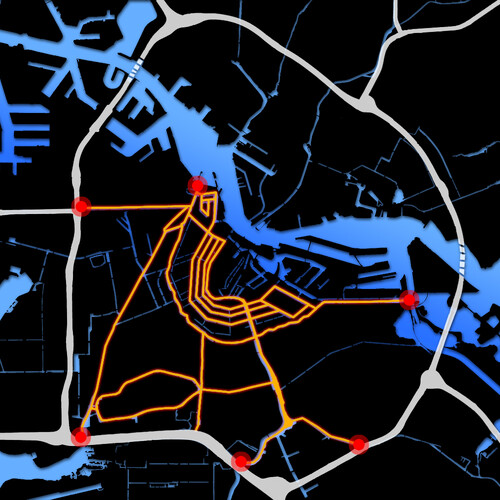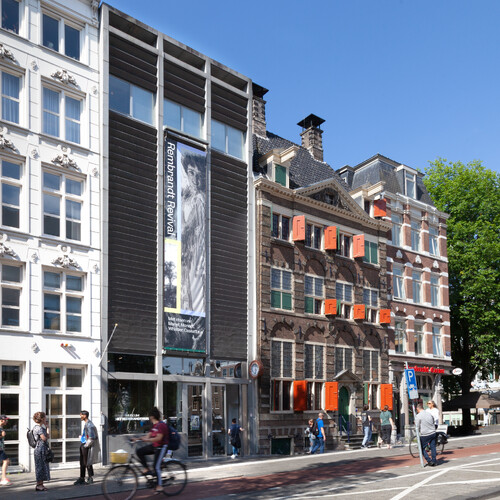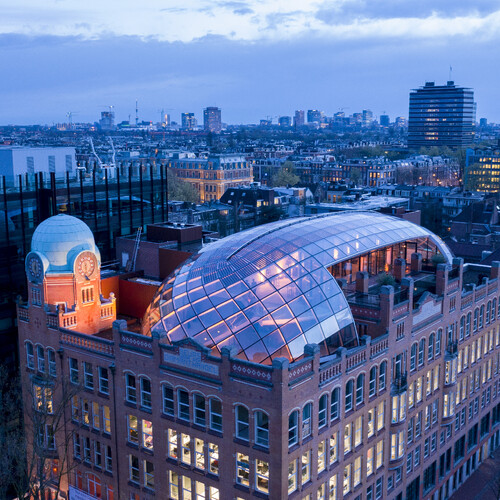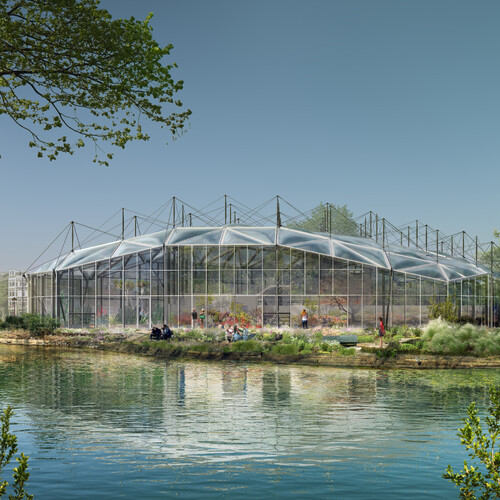0324
Gallery
Competition Nam June Paik Museum, Korea
The works of Nam June Paik, created over the past fifty years, include installations, videotapes, television productions, films and performances. In order to display all of these art forms, the architects ZJA have developed a new museum with exhibition rooms especially suitable for displaying the work of Nam June Paik. The new museum functions as an incentive to the cultural future of Korea as a whole.
During his entire career as an artist, Paik has entered into several collaborations, resulting in innovative works of art. Because of these challenging collaborations, our agency would like to design a museum in cooperation with Nam June Paik, a museum in which room and art challenge one another. Paik often makes several versions of his works. In some cases, he creates a new interpretation of his own work years after the first version. Our design for the museum provides room for existing objects as well as Paik’s re-interpretations of his own work.
Different parts of the museum accommodate different phases in Paik’s works. An installation on the forecourt refers to the work from the 1970’s, when Paik created many installations focused on television: TV Buddha, TV Chair, TV Garden, Magnet TV, et cetera. The Buddha watches his own projection, in a constant loop of filming and projecting, involving visitors.
The long, curved wall alongside the stairs of the museum can be used as a video wall and provides space for Paik’s video wall projects such as Video Flag, Video Funnel, Video Arbor, et cetera. These are typical for Paik's work from the 1980’s. In that same period Paik created his Robots: experimental installations, often built up from monitors. These objects may be placed freestanding almost anywhere in the museum, thanks to the flexible exhibition space. Over the 1980's and 1990's, the artist added neon and laser to his range of techniques. These works of art can also easily be installed in several places in the exhibition rooms. There should also be a place in the museum for Paik’s early work: registrations of his art performances – like the shows that evolved from Paik’s close collaboration with Charlotte Moorman. These may be viewed at leisure in the privacy of cubicles.
The volume of the building follows the contours of the natural hills, transforming the natural landscape into a museum space. In several steps, the building digs itself in and settles into the slope of the hill. Even the façade on the side of the forecourt follows the curve of the elevation contours. The spacious forecourt leads into the museum and can be seen from the sculpture terrace on the first floor of the building as part of the exhibition space.
The curved shape of the building, resulting from the location, leads to a fan-shaped floor map. The organizing grid resembles the pattern of magnet lines. These curved lines correspond to the curves of the landscape’s elevation contours. The building’s pattern is continued in the forecourt. The lines of the seams in the pavement lead the visitors into the museum. A path is marked in a different pattern, leading visitors across the forecourt towards the entrance. This path continues inside the museum, as the same pavement is used on the stairs.
The building is made up of four curved zones. One zone is a service area with parking facilities for visitors and office space for employees. The second and fourth zone is circulation space for staff, fire escape and installation. The third zone is reserved for expositions and the storage of art. Contrary to the list of demands, the parking facilities will be completely integrated within the service area of the building.
The entrance is organised within the circulation space. This area also functions as the link between the ground floor and the first floor. The exhibition rooms are large, multifunctional and neutral spaces, in which the visitor can dwell at leisure. The elevator to the first floor will have a prominent position and will be equipped as a show floor. In this way visitors see the exhibited works of art while they go from the ground floor to the first floor, and back, and will experience the elevator as art.
The zoning of the building offers a clear guideline for future expansion. The service passages and the zones anticipate for the extended building. The more parts of the mountain are transformed into the building, the longer the four zones will be.
In order to highlight the exhibited designs, the exhibition space will have a sober design. The purpose is to optimally involve the visitors in the art of Nam June Paik. This calls for a neutral exhibition space, which does not distract the attention of the visitors from the works of art.
The building has an unrestricted layout: the floor and the ceiling are designed as stainless steel panes. The maximum length and width of the panes is some 200 to 300 mm. They follow the fan-shaped grid of the floor plan, the magnet lines on which the building is structured. All panes can be replaced by panes in which an outlet for electricity or data is integrated. The power supply for the installation of Paik can be installed out of the visitors’ sight.
The most important exhibition spaces are situated into the hill, where there is relatively little natural light. The idea is to illuminate the exhibition space by means of artificial light. In this way the works of art, which are often very sensible to natural light, can be displayed in the best possible way.
A sculpture terrace is placed on the first floor at the front of the building, with a view of the forecourt. Between the exhibition space and the terrace is a transitional zone, where the natural streams of light are dimmed. Behind the curved, glass façade is a high flexible wall, which keeps the natural light out of the exhibition space. This wall screens off a zone alongside the façade on the sculpture terrace. If the weather is bad, this zone serves as a circulation space, from where the sculptures on the terrace can be viewed. Furthermore, the zone can be used to exhibit works of art that can endure natural light, but cannot be placed outside.
By placing the works of Paik in a traditional, museum-like context, his innovative art is raised above the associations that the basics of his work usually bring to mind. In his work, technological means – TV and video – serve an artistic concept. By creating a classical museum-like surrounding with the prospects of modern technology, the museum has the same ambiguity.
A museum is not only a real place but also a transmitter amplifying its subject around the world through the world wide web. In that way, the building also has significance outside of Korea. The project includes the space surrounding the building. We suggest placing three large video billboards with live images from the inside and outside of the museum, one in Seoul, one in Düsseldorf and one in New York.
Related

AMFORA, Amsterdam
A visionary plan
Like all cities, Amsterdam faces increasingly limited space to accommodate more and more people who want to live, work and spend their…

Rembrandt House Museum, Amsterdam
A restoration and a new look
When the Rembrandt House Museum in Amsterdam decided to restore the seventeenth-century house to its original state and enable it to offer…

Diamond Exchange, Capital C Amsterdam, Amsterdam
New life for a monument
Historically an exchange is the meeting place of markets and people, goods and ideas, and that is how the renewed Diamond Exchange meets…

Renovation Climate Greenhouse Hortus Botanicus Amsterdam
The eye-catcher of the Amsterdam Hortus Botanicus was designed in the early 1990s by architectural studio ZJA, as a contemporary structure…






